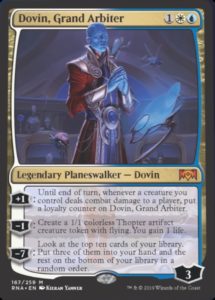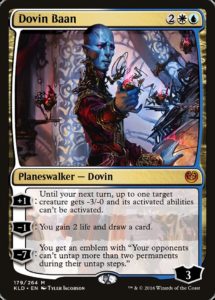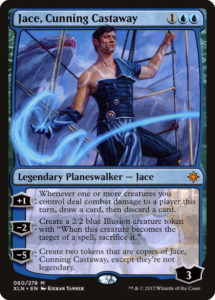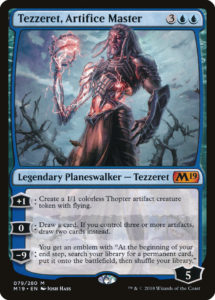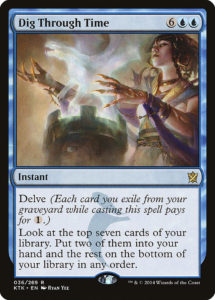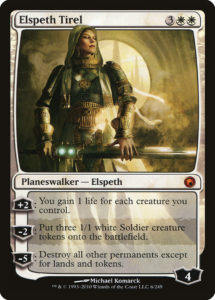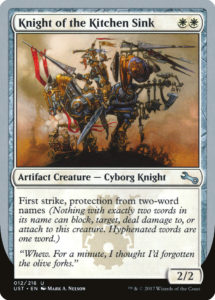Happy new year, friends, and welcome to heart of Ravnica Allegiance spoiler season! I was going to write about Deputy of Detention and the history and pushing of creatures with existing spell effects, but then this happened:
Those of paying attention to the little bits of story knew to expect Dovin would be coming. (Funnily enough, Blogatog has been a much better source of main story Vorthos news than the Magic Story for GRN.) We knew that he’d be designed not to slot into existing Teferi, Hero of Dominaria control decks for fear of them dominating the metagame—funnily enough, Azorius was underpowered originally back in Dissension for fears of WU Control similarly being too strong. Return to Ravnica treated Azorius well, and Standard of that era warped around the power of Sphinx’s Revelation.
But that’s all past knowledge—now we’ve got an actual card to investigate. Before we dive into the mechanical design, we should spend some time on the character of Dovin Baan and the overall design of Planeswalkers and their cards.
Who is Dovin Baan?
Each Planeswalker has their own power set, personality, and style. Every time they are graced with a Planeswalker card, it ought to communicate these elements. Gideon is a fighter and his card should always animate him. His personality is heroic, involving him taking the brunt of or blunting the enemy’s attack (communicating by him forcing enemies to attack him or ‘bubbling’ them on Gideon of the Trials). When he undergoes a change, such as becoming a leader in Gideon, Ally of Zendikar, he switches out his secondary power set for a new one (in this case, making tokens), but he retains his core personality.
You see this trend in all of the major Planeswalkers with at least two printings. Chandra always deals direct damage. Jace always draws cards (that element of mind magic has proven easier to communicate, cost, and capture than his predilection for illusions). Tezzeret and Daretti care about artifacts. Ajani buffs creatures (and sometimes Planeswalkers). Nissa animate lands (I’m a firm supporter of her revision). Sorin makes Vampires (outside of his initial incarnation, which drained life—his secondary power). Garruk summons animals. Liliana gets a broader berth in her abilities (which, granted the Lorwyn Five all got), something that went too far with Lilana of the Dark Realms and led Wizards to restrict their Planeswalkers’ designs and create more when necessary. This brings us to Dovin Baan.
With only a single card, there is little precedent for Dovin’s power suite. He was a tertiary antagonist in Kaladesh (serving under Tezzeret the Schemer and ultimately corralling the truly villainous Baral, Chief of Compliance), so we don’t know terribly much about what he can do besides be cordial, devious, and obsessed with knowledge. His unique power is Karnak’s (the Inhuman from Marvel Comics): he can see the weak spot in anything, which is potent but not easy to communicate mechanically.
With those challenges in mind, let’s now consider the abilities of the card and whether they carve out a clear mechanical space for the third white-blue ‘walker.
A Unique Plus
Until end of turn, whenever a creature you control deals combat damage to a player, put a loyalty counter on Dovin, Grand Arbiter.
This ability combines Jace, Cunning Castaway‘s trigger with Gideon, Champion of Justice‘s effect. Both of them rank among Magic’s weakest Planeswalkers, so this isn’t an inspiring start. Sure, three mana Planeswalkers tend to be better than they look by virtue of coming down super early; but this is an ability that does absolutely nothing to the board, requires major deckbuilding concessions, and only helps if you’re trying to hit Dovin’s ultimate. Many Planeswalkers are judged by their ability to protect themselves and this ability discourages you from leaving blockers back to protect the loyalty you’re amassing.
Mechanically, this ability encourages an aggressive white-blue deck, or at least one that can plink away with fliers (such as Dovin’s thopters, a synergy I quite enjoy) while keeping Dovin safe. I really like the absurdity of Dovin functioning best alongside a wily gang of pirates and Merfolk, but that’s some of the best Standard support presently available (before we see more Azorius spoilers).
Thematically, I really like this ability. Dovin Baan is about order through knowledge and this plus lets him amass power through scouting parties. He doesn’t care how hard you hit your opponent, only that your forces circumvent their defenses. He’ll then use this knowledge as a weapon later on.
A Familiar Minus
Create a 1/1 colorless Thopter artifact creature token with flying. You gain 1 life.
This minus is Tezzeret Artifice Master‘s 0 with Dovin Baan‘s additional lifegain rider. Having the 0 ability of a five mana Planeswalker as a -1 on a three mana Planeswalker is quite potent, and incidental lifegain is always welcome.
I absolutely love this ability. It’s super evocative of how incongruent this off-worlder is in the context of Ravnica. Sure, he’s in charge of the Azorius Senate, but he is from Kaladesh and will use his Consulate skills and techniques to get the job done if you can’t be bothered to help. Serve him with your own creatures, or let him get the job done himself with his Thopter Spy Network. I also love how well it plays with his plus ability. This is the kind of ability that would feel really incongruent on Ravnica (which is the whole point) or on basically any Planeswalker, yet it makes perfect sense on Dovin. Abilities like this make for excellent secondary power suites since they’re such mechanical and flavor wins without being the character’s primary power.
An Ultimate that Doesn’t Win but kinda definitely still does
Look at the top ten cards of your library. Put three of them into your hand and the rest on the bottom of your library in a random order.
Most Planeswalkers’ ultimates tend to win the game (with perhaps a hurdle or two for you to make the finisher blow). They also tend to be the most minor consideration since they require you controlling a Planeswalker for several turns. Dovin’s warrants far more consideration considering the whole point of his plus is getting there. In fact, if you go one drop, two drop, Dovin and attack (6 loyalty), you can ultimate Dovin on turn five without even needing to attack on turn four (or hit with one creature on turns three and four).
The ultimate’s effect is an even more powerful version of Dig Through Time. Drawing three cards off a three mana Planeswalker is pretty solid, but tutoring for three is bonkers. The cool thing about the ultimate is how in tension it is with the plus—Dovin wants you to play lots of cheap, evasive threats to set up his ultimate, but the ultimate only does strong work if your deck contains powerful threats and answers.
Also, I love that Dovin continues the paradigm of putting cards on the bottom of your library in a random order. What order those seven hit the bottom in is mostly inconsequential, particularly when you’ve just ultimated a Planeswalker. Since it might as well be random, better to avoid the confusion and make it explicitly so.
Putting it All Together
Dovin, Grand Arbiter‘s design comes together to tell a story. Dovin is a man who controls via information. His card doesn’t have the actual abilities of Thopter Spy Network, but they’re just evocative enough of the card to tell you what he’s trying to do—gather tidbits of intel in order to gather enormous huge swaths of information. Dovin is not here to win the game for you (or Bolas); he’s here to know all that he can, to advise you as best he can, and to do it by making Ravnica play by his Kaladeshi Consulate rules. He is the new Grand Arbiter, and he’s probably not making many friends.
Wrapping It All Up
As you may have noticed, there are a lot of knobs to and expectations of Planeswalker designs. We expect them to see Standard play. They need to excite players to buy packs and play the game. Each should communicate a personality and a unique power set. They often need to have synergy between their abilities, or require big deckbuilding concessions. And each ability tells a story that must fit the character’s precedent and the needs of the current story while keeping them broad enough that they can return on future cards.
Even the most common template, that of Ob Nixilis Reignited, Jace, Unraveler of Secrets, Vivien Reid, Teferi, Hero of Dominaria, Angrath, the Flame-Chained, and Ral, Izzet Viceroy, is something expressed differently each time according to the character conveyed and the restrictions of the color pie. There’s a whole lot of game design insight one can glean from just a single Magic card, and I never tire of delving.
—Zachary Barash is a New York City-based game designer and the commissioner of Team Draft League. He designs for Kingdom Death: Monster, has a Game Design MFA from the NYU Game Center, and does freelance game design. When the stars align, he streams Magic.
His favorite card of the month is Growth Spiral. Explore is one of his favorite designs ever, and this is not only the same card, but it avoids the complexities of playing extra lands. Also, have you seen that artwork by Seb McKinnon?

